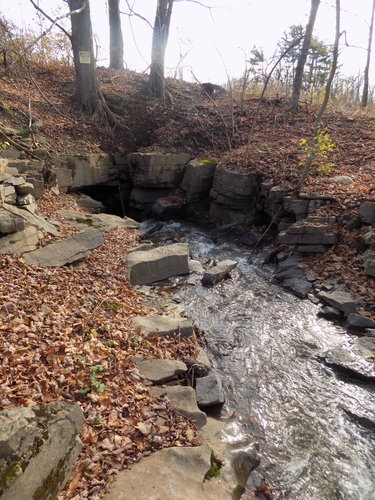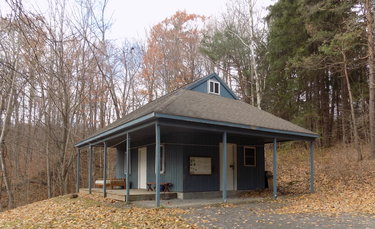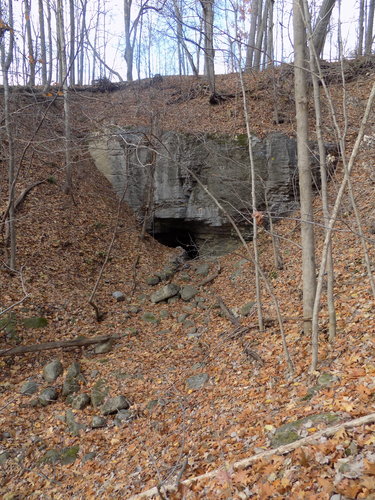Cave preserves protect the unseen world beneath our feet
The precise locations of the caves referred to in this column have been left deliberately vague to protect both the caves and inexperienced persons who might wish to enter them. Those interested in local cave exploration are urged to check out the website of the Northeastern Cave Conservancy — www.necaveconservancy.org — and to consider a cave trip tailored to their abilities during the period between May 1 and Sept. 30 when the caves are open to visitors.
One might — in a whimsical moment — regard it as “The Spelean Archipelago.”
Though sport — and scientific — cavers have long frowned upon the term “spelunker,” the noun “speleology” — the scientific name for the study of caves, derived from “spelaion,” the Greek word for a cave — and the adjective “speleological” have long been standard usage.
Across the United States, preserves in karst areas dot the map, ranging in size from a single acre to hundreds — karst” being the term for a region of limestone or marble bedrock containing caves. In our part of the country they are owned and/or managed by two organizations: the Northeastern Cave Conservancy, which recently celebrated its 40th anniversary, the website of which declares that its mission is the conservation, study, acquisition, and management of northeastern caves; and the National Speleological Society, today an international, organization of sport and scientific cave explorers.
The organizations are commonly referred to respectively as “the NCC” and “the NSS.” Their preserves protect numerous caves, the watersheds they involve, the unique life within them, and the classic karst surface features such as sinkholes, disappearing streams, and springs. Many local cavers are members of both organizations, the websites of which detail the history and geology of the various preserves.
From Oct. 1 to the end of April, many Northeastern caves — and all of those under the ownership or management of the NCC and the NSS — are closed to protect the caves’ bat populations, which in recent years have been ravaged by the insidious disease known as White Nose Syndrome.
Commercial caves such as Howe Caverns and a number of privately-owned caves that do not harbor bats remain open; however, winter has never been a very popular time for sport caving except for the most dedicated, given the fact that Northeast caves are almost by definition very wet, and slogging through snow in subfreezing temperatures to and from the caves can be extraordinarily miserable.
The National Speleological Society was founded in 1941 by a small but dedicated group of cave explorers and since has grown to an international organization with thousands of members. In the Northeast, the NSS owns three Schoharie County cave preserves: the Schoharie Caverns Nature Preserve; the James Gage Karst Preserve; and McFails cave, the most extensive in the Northeast. All three properties were donated to the NSS by generous patrons and have been maintained over the years by dedicated volunteers.
Knox Cave tragedy leads to stewardship
Yet the NCC was born as the final result of a tragic caving accident in 1975.
In May of that year, several college students from Albany were attempting to enter Knox Cave, which even late in the season still had a huge mass of ice encrusting the part of its sinkhole above the entrance.
The cave near the hamlet of Knox had sporadically been run as a commercial operation like Howe and Secret Caverns in Cobleskill, most famously under the ownership of Delevan C. Robinson and his wife, Ada. In the mid-20th Century, the couple were responsible for the building of an elaborate staircase offering access to the cave, which lies over 100 feet underground, and for constructing walkways and installing lighting for tourists.
D.C. seems to have had what the Irish call “the gift of blarney”: Some of his descriptions of the cave and its extent were — to put it gently — fanciful. But the cave features both large, easily-accessed passageways and more challenging sections that require stamina and sometimes ropework of explorers and it has attracted serious cavers for many generations as well as tourists during the relatively brief periods when it was commercialized.
The Robinsons also built a large roller rink adjacent to the cave’s entrance sinkhole that for a while, in the 1940s and 1950s, was the scene of skating parties and country dances. It seems to have formed a center of social life for the Hilltowns in the days when not many hardworking Helderberg folks could afford the time or the money to travel to nearby cities for entertainment.
But following D.C.’s death, commercial operation of the cave ended for the last time in 1961, though sport cavers and scientists continued to gain access to Knox with the kind permission of D.C.’s widow, Ada, until she died in 1964.
Some time in the mid-1960s, the largely abandoned property was purchased by a Long Island corporation called “Organa Industries,” which announced its intention to restore the cave and dig out a boulder-choked sinkhole adjacent to its classic entrance to allow a through trip. But Organa Industries went belly-up and the restorations never took place.
Old-timers in the Knox area may remember the huge steam shovel that stood for years in the field next to the commercial entrance but it seems never to have been employed in digging the clogged sinkhole and it eventually collapsed into a rusty pile of warped metal and cables.
The result was that access to Knox Cave was without any sort of control; in the years that followed, the staircase and the walkways deteriorated and the lighting system and many of the cave’s natural decorations were vandalized, and the skating rink and the Robinsons’ 200-year-old farmhouse were torched.
Even the massive frozen waterfalls that formed in winter from drainage in the fields around the Knox sinkhole did not deter visitors from entering the cave. Sometimes the warmer (48-degree) air within the cave would melt a tight hole allowing access to the adventurous — or risk-takers — while at other times the even more foolhardy were rumored to be using sledge hammers to smash their way through the ice to gain entrance.
In any case, one day in May 1975, as a group of Albany students tried to enter the cave through its ice-encrusted entrance, spring runoff from surrounding fields poured in a cascade behind the ice deposits. The result was that a massive block of ice broke away and came crashing down, killing one student and leaving another paralyzed from the neck down.
By that time, the cave and surrounding land had been sold for non-payment of taxes to a doctor from Schenectady. Fearing additional injuries and lawsuits, the doctor attempted to donate the cave to the National Speleological Society. But the same fears caused the NSS to reject the offer, and a group of cavers became concerned that the cave might be acquired by someone who would ban all exploration or even bulldoze its entrance sinkhole effectively closing it permanently.
Thus, in 1978, three area men — Robert Addis, Dr. Art Palmer, and Jim Harbison — formed the Northeastern Cave Conservancy as a not-for-profit group and Knox Cave has continued to be made available to qualified cavers.
Over the years, subsequent exploration has added close to 1,000 feet of previously unknown passage to the map of Knox Cave and revealed another segment of passage yet to be connected to Knox known as Crossbones Cave. And, over the years, through purchase or donation, the NSS and the NCC have acquired a number of other parcels of land containing caves that are also well-known to explorers.
Caves galore
A western portion of the Helderberg Plateau known as Barton Hill in Schoharie County rises steeply above the Fox and Schoharie creeks. A standing joke among cavers is that the hill is hollow because of the numerous caves that underlie it.
One large parcel of land owned by the NSS was donated by the Gage family and contains the Schoharie Caverns, which resembles a slot canyon; its entrance lies at the base of a limestone cliff on the edge of the plateau. Schoharie Caverns consists of nearly half a mile of streamway featuring beautiful stalactites and stalagmites that decades of visits by college outing clubs and other groups have left marvelously intact.
A rather spartan cabin on the property is maintained by local cavers and is available for groups visiting Schoharie Caverns and other nearby cave preserves.
And there are many. The NSS also owns another large parcel of land on Barton Hill known as the James Gage Karst Preserve; it contains Ball’s Cave, named after its 19th-Century landowner.
Its vertical entrance lies in a heavily-wooded section of the hill and has drawn visitors for over 150 years. The cave features immense rooms as well as low crawl ways, and a diminutive flooded segment of the cave known as the “Lost Passage” requires cavers to experience a chilling “ear dip” to pass through it. (Do you really want to ask?)
Although there are a number of other known or suspected caves on Barton Hill not under the control of the NSS or the NCC, Spider Cave was recently donated to the NCC by a local landowner. Its alluring entrance has been described as “Storybook,” but explorers have found that it is a very short story except for those with the intrepidity to challenge its agonizingly tight, wet main passage that extends for over a thousand miserable feet into the plateau.
And those who enter its easily accessible first hundred or so feet will encounter scores of its eponymous creepy occupants scampering across the cave’s water-smoothed walls.
McFails is the jewel
Generally considered the “jewel in the crown” of Northeast caves is McFails Cave on the Cobleskill Plateau. Its entrance is in a beautiful hemlock-and-hardwood forest pockmarked with gaping vertical sinkholes, some of which take voluminous quantities of water from time to time.
Only a short and very unpleasant segment of McFails was known until 1961 when some students from Cornell University plunged through a pool with only a few inches of airspace and discovered that the cave did not end at the uninviting pool. Today the cave is known to be over seven miles in length, much of which consists of high canyons and large chambers beautifully decorated with calcite formations.
But the cave can be treacherous: Entrance requires rappelling down 70 feet — in wet weather through a waterfall — and much of a cave trip involves constant immersion in a cold stream, making the wearing of a wetsuit a necessity. The cave has been hydrologically connected to other caves on the plateau, meaning that water in them them has been traced to McFails.
Thus the potential exists for a cave system some 26 miles in length — a fact likely to draw intrepid explorers for years to come.
Clarksville Cave is the best known
Undoubtedly the NCC-owned cave that is best known to the general public is Clarksville Cave, which has drawn visitors for well over 150 years. Groups from camps, schools, churches, and colleges regularly visit the cave between May 1 and Sept. 30.
Clarksville has three known entrances and lies beneath a hardwood forest laced with nature trails. While much of the cave consists of subway-tunnel size passages, more adventurous visitors are drawn to its tight — and wet — challenging sections that lead to pools and a picturesque waterfall.
Despite its easy accessibility and heavy traffic in summer months, much of the cave is relatively pristine and its numerous classic features both above and below ground make it a veritable textbook example of cave and karst geology.
Ominous Onesquethaw
Not far from the village of Clarksville is the lesser-known Onesquethaw Cave also owned by the NCC. Named for the stream that flows through the valley in which its entrance lies, its low, twisting passages are studded with fossils and its sometimes maze-like layout gives the cave a certain allure.
But Onesquethaw is not for the novice cave explorer and has long had a somewhat ominous reputation. It lies in a low area that is prone to flooding and, in times of sudden heavy precipitation, a roaring stream enters the cave and can fill its passages to the ceiling.
In 1991, a group of college students became briefly trapped in Onesquethaw when a torrential surge of water flooded the cave, setting off a massive rescue effort involving the Albany-Schoharie Cave Rescue group and local fire companies as well as news organizations from all over the Northeast.
The students had fortunately found a room with a high ceiling and were able to cling to the walls until the water levels finally dropped and allowed them to leave the cave.
As the students’ experience in Onesquethaw Cave demonstrates — the subterranean world demands respect of those who enter it. The Northeastern Cave Conservancy and the National Speleological Society have not only managed to acquire and keep open many classic Northeastern caves for qualified visitors, the groups have educational and scientific components as well.
Through work with the general public as well as scientists and qualified students, ranging from grade school right up through university-level, the organizations have helped to maintain and protect the resources of the world beneath our feet.
And the NCC and the NSS are not alone. All across the 48 contiguous States and in Alaska and Hawaii, many hundreds of acres of karst lands and areas underlain by lava caves have been acquired and protected by organizations of dedicated cavers — a “spelean archipelago” indeed.
Could statehood be far behind?





